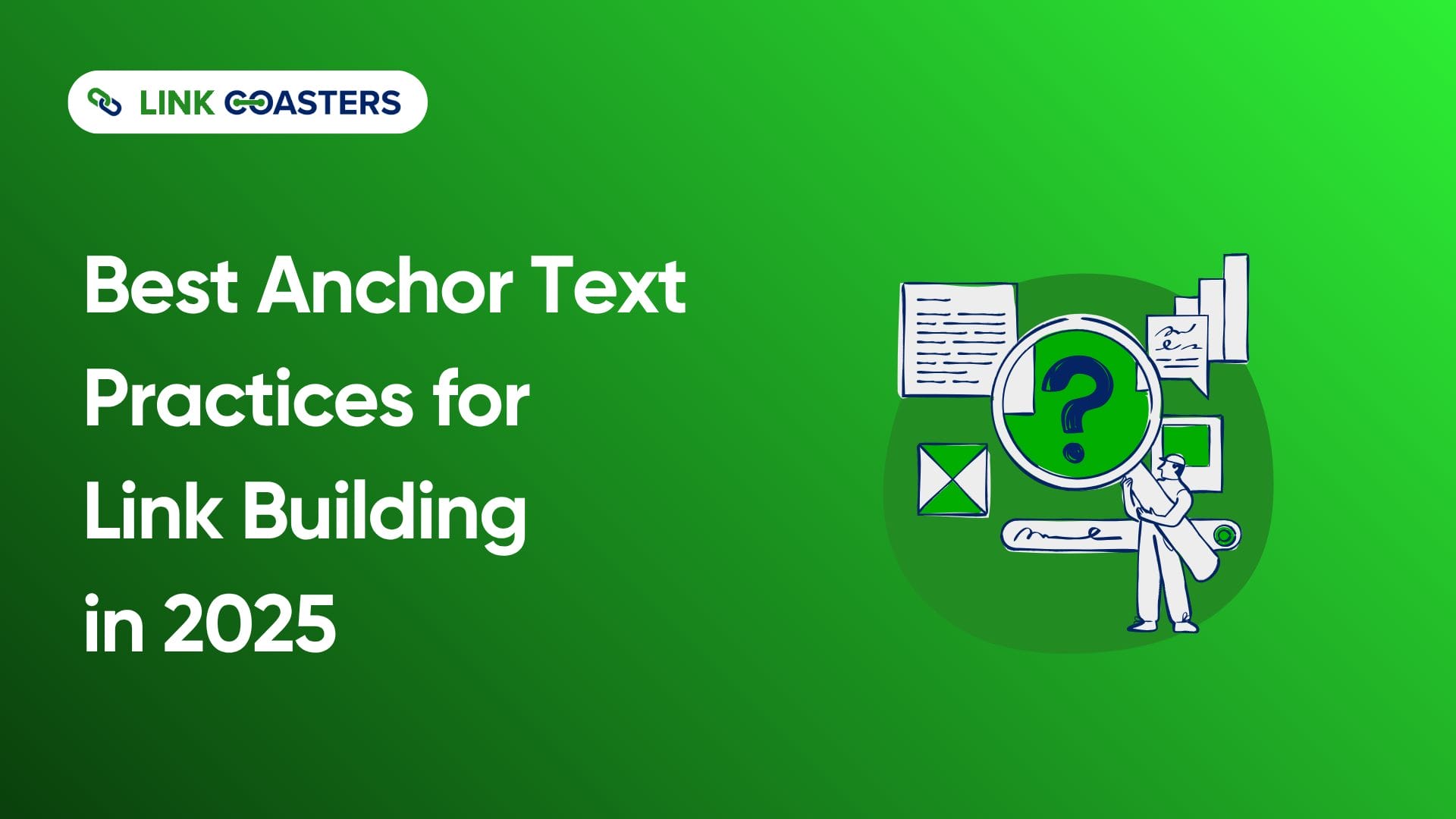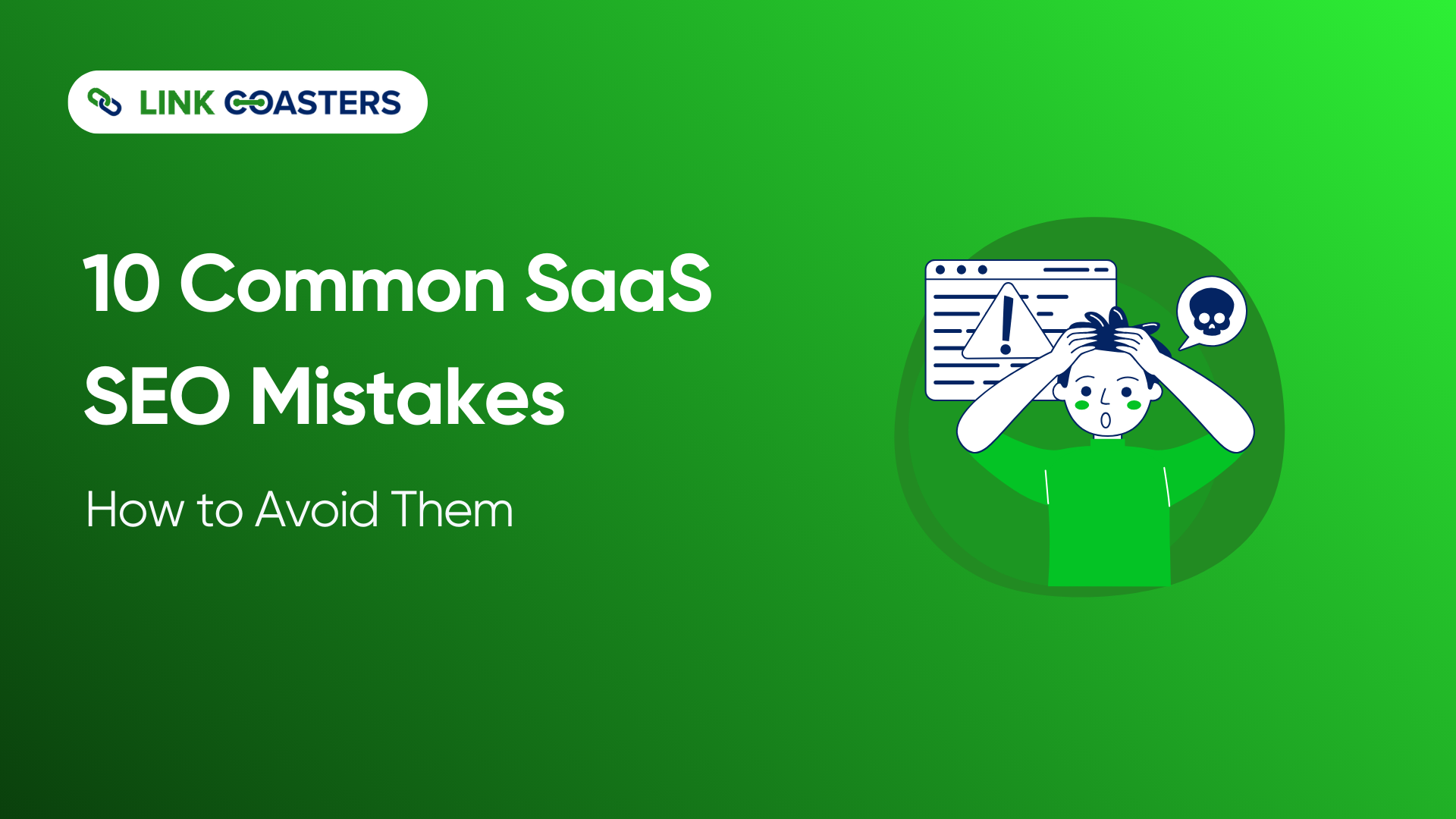Building backlinks is only half the job. If Google never finds and indexes those links, they won’t give your site any SEO value. This is a hidden problem many website owners face.
They put in the work to earn strong links, but see little to no ranking improvement because those backlinks aren’t being picked up by search engines.
Backlink indexing refers to search engines identifying, crawling, and adding your backlinks to their database. Without proper indexing, your link building efforts remain invisible to Google’s ranking algorithm.
This guide reveals proven methods to accelerate backlink indexing. You’ll learn how Google discovers links, what factors influence indexing speed, and actionable strategies to get your backlinks indexed faster.
What Is Backlink Indexing?
Backlink indexing occurs when search engines discover and record links pointing to your website. This process involves:
- Crawling the linking page
- Recognizing the link
- Adding it to the search engine’s index database
Here’s the reality: Google doesn’t automatically know about every backlink to your site. The search engine must first crawl the page containing your link, then recognize and record that link in its system. Only indexed backlinks contribute to your site’s authority and rankings.
The indexing process happens through Google’s web crawlers, also called Googlebots. These automated programs continuously scan the internet, following links from page to page and updating Google’s massive index database.
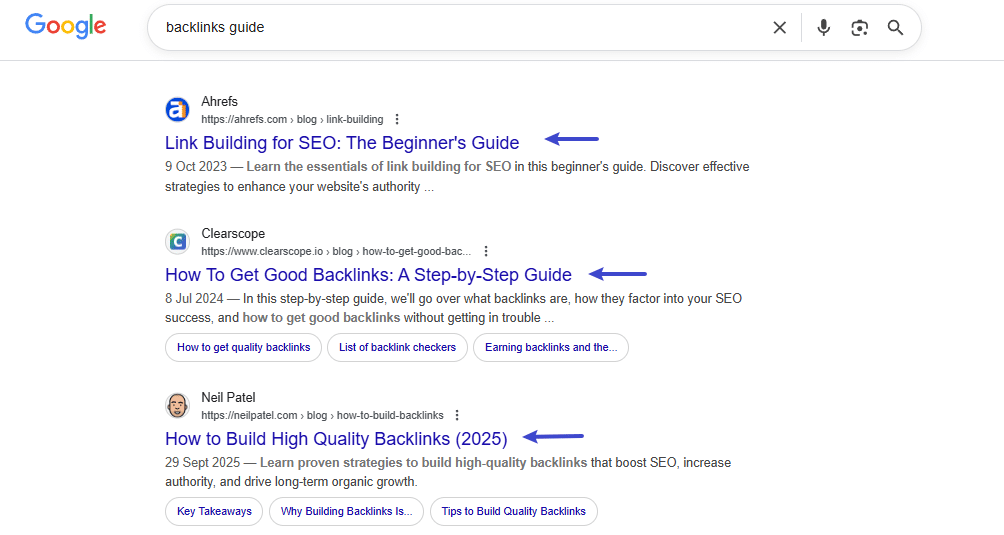
Think of indexing as making your backlinks “visible” to Google. Unindexed backlinks exist online but remain hidden from search engines. They provide no SEO benefit until Google discovers and processes them.
Key factors that influence backlink indexing:
- Authority of the linking page
- Crawl frequency
- Technical accessibility
- Link relevance
How Long Does It Take Google to Index Backlinks
Google typically crawls and indexes backlinks within a timeframe of days to weeks, although this can vary depending on several factors.
- High-authority news sites: 24-48 hours
- Popular and frequently updated sites: 3-7 days
- Small, infrequently updated sites: Weeks to months
- New domains with low authority: Several months (or never)
Note: Some backlinks never get indexed, especially those from low-quality sources, blocked pages, or sites with technical issues. Knowing the limitations ensures your link building campaigns are based on achievable outcomes.
How Can You Index Backlinks Faster?
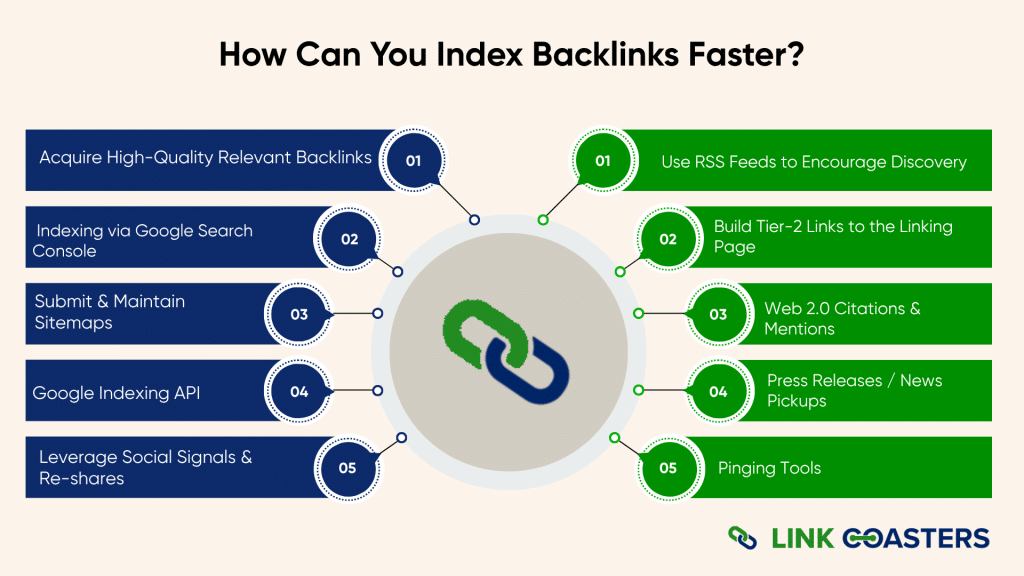
Acquire High-Quality Relevant Backlinks
Backlinks aren’t all indexed at the same speed. High-quality links from trusted, authoritative sites usually get picked up much faster because Google crawls those sites more often.
- Established sites with strong domain authority get crawled more frequently
- Fresh, regularly updated content stays on Google’s radar
- Relevant backlinks (same topic/niche) get indexed faster
- Well-optimized pages with good UX receive more crawler attention
Best sources for fast indexing:
- News sites and popular blogs
- Industry publications
- Established directories
- Frequently crawled websites in your niche
Direct your link building efforts toward websites that Google crawls on a regular basis. The SEO health of the page linking to you also makes a difference. If that page loads quickly, is well-optimized, and gives visitors a good experience, Google crawls it more often.
Request Indexing via Google Search Console
Google Search Console provides a direct method for requesting page indexing through its URL Inspection tool.
How to use it:
- Submit the URL of the page that contains your backlink
- Click “Request Indexing“
- Monitor status through Coverage reports
Pro tip: Use this wisely for your most valuable backlinks rather than submitting every single link. Google limits the number of indexing requests per property, so prioritize high-impact opportunities.
Submit & Maintain Sitemaps
XML sitemaps help Google discover pages more efficiently by providing direct lists of URLs for crawling.
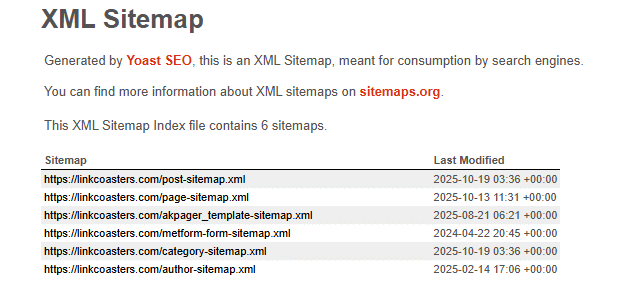
How sitemaps help with backlink indexing:
- Increase the crawl frequency of linking pages
- Create indirect acceleration for outbound link discovery
- Signal important content updates to Google
Ensure websites linking to you maintain updated sitemaps that include the pages containing your backlinks. Some websites accept suggestions for sitemap inclusions, especially for high-quality content they’ve linked to.
Additional benefit: Submit your own sitemap regularly to encourage more frequent crawling of your site. When Google pays more attention to crawling your site regularly, it often creates a ripple effect that helps discover your backlinks faster too.
Google Indexing API
Google’s Indexing API lets you submit URLs directly for crawling, but it’s mainly meant for specific content types.
- Job postings
- Live stream pages
- Time-sensitive structured data
Limitations:
- Requires technical implementation and Google Cloud Platform setup
- Limited use for general backlinks
- Most small businesses find manual Search Console submissions more practical
Focus on other proven methods before investing time in API implementation. Manual techniques often provide better cost-benefit ratios for most link building campaigns.
Leverage Social Signals & Re-shares
Social media sharing can accelerate backlink indexing by creating additional pathways for Google to discover your links.
How social signals help:
- Increase page visibility and crawl priority
- Create engagement signals that prompt more frequent crawling
- Social platforms themselves get crawled regularly by Google
Links shared on major social media platforms often receive indexing attention more quickly than those buried on obscure websites.
Use RSS Feeds to Encourage Discovery
RSS feeds provide structured pathways for search engines to discover new content and links.
- Google crawls many RSS feeds regularly
- Creates automatic notification systems for new content
- Acts as a discovery bridge for your backlinks
Tips:
- Ensure linking sites include your links in their RSS feeds
- Submit RSS feeds to major aggregators and directories
- Create your own RSS feed highlighting linking websites
Build Tier-2 Links to the Linking Page
Tier-2 link building, which involves generating links to the pages that are already linking to your website.
- Focus on your most valuable backlinks (not every single link)
- Prioritize high-authority domains where faster indexing matters most
- Use diverse sources: social media, directories, and relevant forums
- Monitor both primary and tier-2 indexing status
The goal: Increase the linking page's visibility and crawl priority through multiple discovery pathways.
Web 2.0 Citations & Mentions
Web 2.0 platforms like Medium, LinkedIn, and Tumblr often receive frequent crawler attention.
Strategy: Create valuable content on these platforms that naturally mentions or links to pages containing your backlinks. This creates interconnected discovery webs that search engines can follow.
Important: Stay consistent with your Web 2.0 efforts instead of posting here and there at random. Regular updates build authority over time and increase crawler attention.
Press Releases / News Pickups
Press releases distributed through legitimate news wire services often get indexed rapidly.
Why press releases work:
- High authority of news websites
- Frequent crawling of news platforms
- Creates high-authority discovery pathways
How to maximize results:
- Write newsworthy press releases with natural link inclusions
- Focus on industry-specific outlets (not generic services)
- Follow up with social media promotion
- Combine news distribution with social signals
Pinging Tools
Ping services notify search engines and directories about new or updated content.
How to use pinging effectively:
- Use reputable services (avoid mass pinging tools)
- Ping specific pages containing your backlinks
- Focus on quality over quantity
- Combine with other indexing strategies
Reality check: While less effective than in the past, strategic pinging can still contribute to faster backlink discovery. Modern search engines place less emphasis on ping notifications than on natural discovery methods.
To learn more about backlinks, check out our complete backlinks guide for a full overview.
How to Know Your Backlinks Are Indexed
Check Google’s Index
Method 1: Site search operator
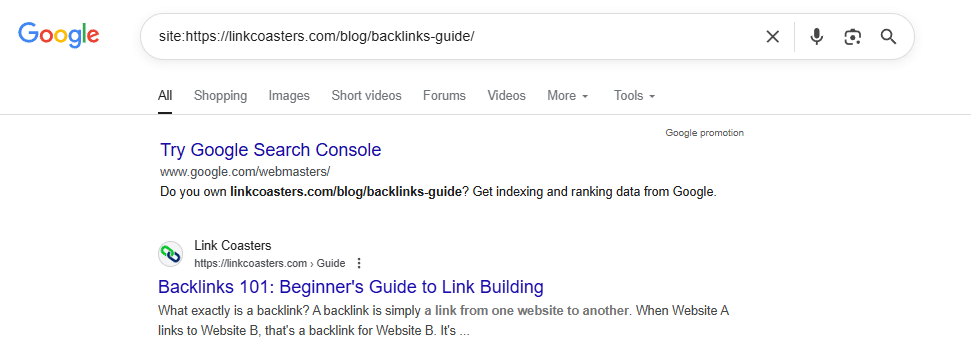
- Search for “site:YourURL“
- Look for the specific page containing your backlink
- Include unique text from around your backlink for verification
Method 2: Google cache
Use Google’s cache feature to see the version of the page that Google has actually indexed and stored. Remember that Google may index pages without displaying them in search results.
Track in GSC
Google Search Console provides the most authoritative data about your backlinks through its Links report.
What to monitor:
- Total number of linking domains
- Individual backlinks over time
- Increases indicating successful indexing
Important timing note: The Links report updates regularly, but not in real-time. Allow several weeks for new backlinks to appear in Search Console data after they’ve been indexed.
Pro tip: Cross-reference Search Console data with your link building records to identify which backlinks have been successfully indexed and which still require attention.
How to Monitor & Troubleshoot Backlink Indexing Issues?
Using Google Search Console for Backlink Monitoring
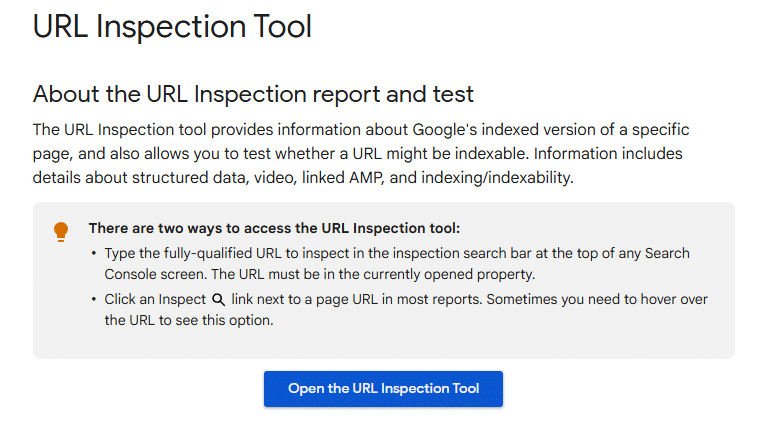
- Coverage report identifies indexing issues affecting linking pages
- URL Inspection tool, which reveals detailed crawling and indexing information
- Alerts notify you of significant backlink profile changes
Identifying Technical Indexing Barriers
- Robots.txt blocks
- Noindex tags
- Server errors
- Slow loading speeds
- Login-required pages
- Heavy JavaScript rendering
What to audit:
- Linking pages are accessible to search engine crawlers
- No robots.txt blocks preventing access
- Pages load quickly without errors
- Proper HTML structure (not heavy JavaScript)
Improving Source Page Authority and Crawlability
- Work with linking websites to improve SEO health
- Encourage better internal linking structure
- Suggest content updates to trigger fresh crawls
- Help resolve technical SEO issues
Benefit: Better-optimized sites get crawled more frequently, which speeds backlink indexing for both parties.
What Should You Avoid When Indexing Backlinks?
Don’t Buy Mass Link Packages that promise instant indexing
Why this fails:
- Uses manipulative techniques violating search engine guidelines
- Google detects unnatural indexing patterns
- Risk of ranking penalties or complete deindexing
- Temporary gains followed by long-term damage
Put your efforts into earning real quality backlinks from reputable websites. Authentic links from trusted sources get indexed naturally and carry long term SEO value.
Don’t Build Links on Low-Quality or Non-Indexable Pages
- Blocked or error-prone pages
- Spam-flagged sites
- Comment sections with poor indexing rates
- Low-quality forums or directories
Before building links, check:
- Linking source maintains good indexing status
- Pages are crawlable without barriers
- Site doesn’t have indexing restrictions
Remember: Quality linking sources require more effort to obtain but provide significantly better indexing rates and SEO benefits.
Don’t Use Unnatural Link-Building Tactics
- Link schemes
- Private blog networks (PBNs)
- Artificial link creation methods
- Over-concentrated link patterns
Why Google ignores these: Manipulative link building techniques often create indexing problems because search engines recognize and avoid processing suspicious link patterns.
Better approach: Earn links naturally by publishing content people actually want to reference, building genuine relationships in your industry, and promoting your work through trusted channels.
Don’t repeatedly submit the Same URL in Search Console
- Can be interpreted as spam
- May actually slow the indexing process
- Wastes your limited submission quota
Best practices:
- Allow a reasonable time between indexing requests
- Focus on the most important backlinks only
- Track results to understand what works
- Use data to optimize future submissions
Conclusion
Backlink indexing is the process that transforms your link building into real SEO gains. Until a backlink is indexed, even the highest quality backlink won’t help your rankings or send referral traffic.
Key Takeaways
- Focus on quality over quantity
- Combine multiple indexing strategies
- Monitor results and adjust based on data
- Maintain ongoing relationships with linking sites
High-authority, relevant backlinks from well-maintained sources index faster and provide better long-term SEO value. The most effective campaigns use content quality, technical optimization, social signals, and strategic submissions together.
Tips to Remember: Think of indexing as an ongoing process, not something you set and forget. Stay connected with the sites that link to you, and make sure their pages remain healthy and crawlable. Supporting those relationships helps ensure your backlinks stay indexed and valuable over the long term.
FAQ
Use the “site:https://linkcoasters.com/” search operator to check if linking pages are indexed, then verify your specific backlink appears. Google Search Console’s Links report also shows discovered backlinks over time.
Submit the linking page in Google Search Console, share it on social media, or build tier-2 links pointing to it to encourage faster crawling and indexing.
Instant indexing isn’t guaranteed. However, using Google’s Indexing API (for supported content types) or submitting the URL in Search Console can accelerate the process.
Regardless of website or agency, backlinks are indexed through Google’s systems. Use sitemaps, content promotion, and indexing requests to help Google discover them.
Focus on quality. Backlinks on authoritative, frequently crawled sites get indexed faster. Combine this with sitemaps, indexing requests, and social signals for speed.
Crawling happens when Google visits the page that contains your backlink. Indexing goes a step further, it means Google has actually processed that page and stored the backlink in its database.




